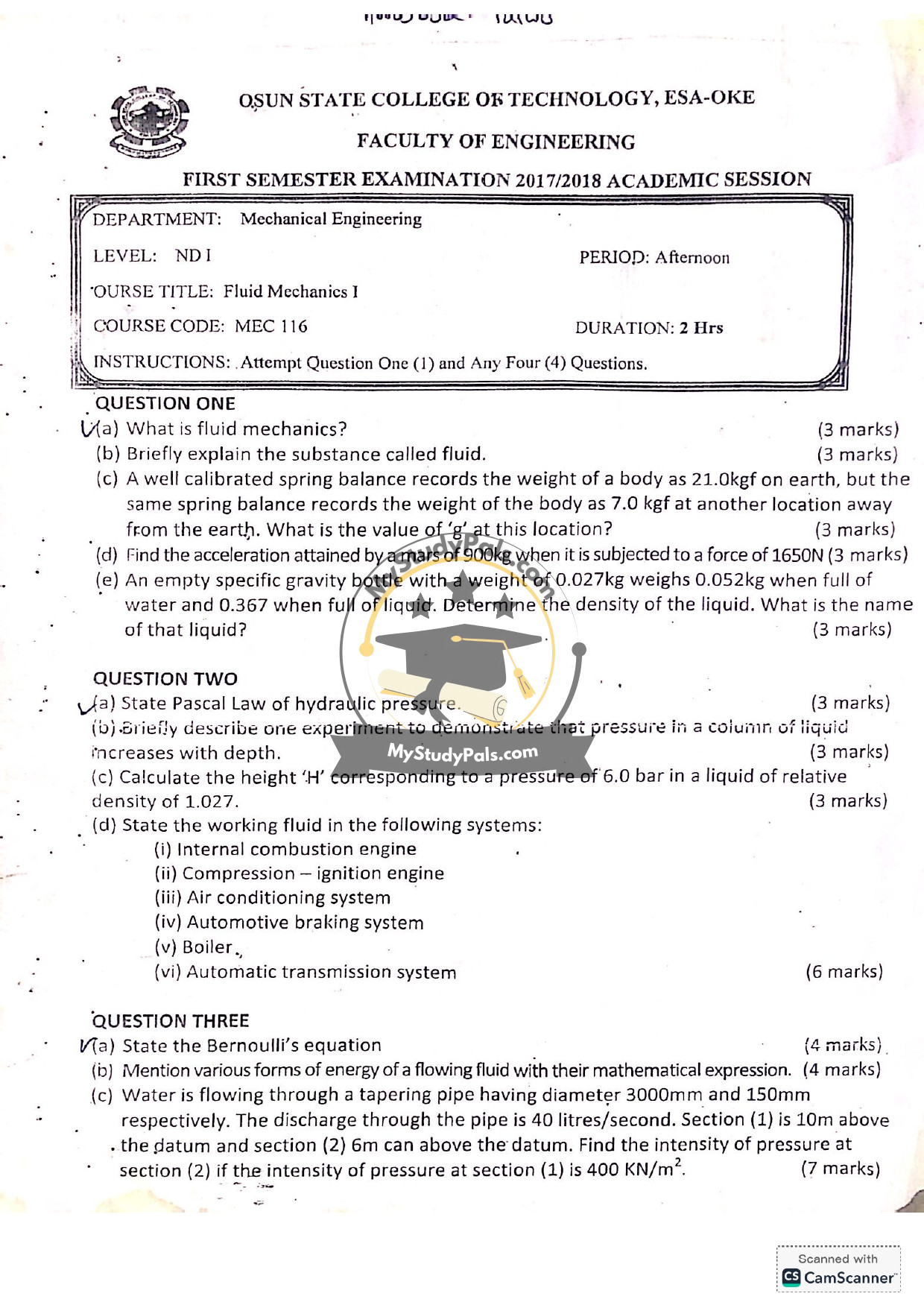ANWSER
Question 1:
(a) Fluid mechanics is the branch of physics and engineering that studies the behavior of fluids (liquids and gases) at rest or in motion, and the forces acting on them.
(b) A fluid is a substance that deforms continuously under the application of shear stress, no matter how small. It includes both liquids and gases, which can flow and take the shape of their container.
(c) Given:
– Weight on Earth, \( W_e = 21.0 \, \text{kgf} \)
– Weight at location, \( W_l = 7.0 \, \text{kgf} \)
– Acceleration due to gravity on Earth, \( g_e = 9.81 \, \text{m/s}^2 \)
Using \( W = mg \), the value of \( g \) at the location is:
\[
g_l = \left( \frac{W_l}{W_e} \right) \times g_e = \left( \frac{7.0}{21.0} \right) \times 9.81 = 3.27 \, \text{m/s}^2
\]
(d) Given:
– Mass, \( m = 900 \, \text{kg} \)
– Force, \( F = 1650 \, \text{N} \)
Using Newton’s second law, \( F = ma \):
\[
a = \frac{F}{m} = \frac{1650}{900} = 1.83 \, \text{m/s}^2
\]
(e) Given:
– Weight of empty bottle, \( W_{\text{empty}} = 0.027 \, \text{kg} \)
– Weight of bottle + water, \( W_{\text{water}} = 0.052 \, \text{kg} \)
– Weight of bottle + liquid, \( W_{\text{liquid}} = 0.367 \, \text{kg} \)
Mass of water, \( m_w = 0.052 – 0.027 = 0.025 \, \text{kg} \)
Mass of liquid, \( m_l = 0.367 – 0.027 = 0.340 \, \text{kg} \)
Density of water, \( \rho_w = 1000 \, \text{kg/m}^3 \)
Relative density of liquid, \( RD = \frac{m_l}{m_w} = \frac{0.340}{0.025} = 13.6 \)
Density of liquid, \( \rho_l = RD \times \rho_w = 13.6 \times 1000 = 13600 \, \text{kg/m}^3 \).
The liquid is likely mercury.
—
Question 2:
(a) Pascal’s Law states that pressure applied to a confined fluid is transmitted undiminished in all directions and acts equally on all surfaces in contact with the fluid.
(b) One experiment to demonstrate that pressure increases with depth involves a tall container filled with water and small holes at different heights. When the container is filled, water jets from the lower holes travel farther than those from the higher holes, showing that pressure increases with depth.
(c) Given:
– Pressure, \( P = 6.0 \, \text{bar} = 6 \times 10^5 \, \text{Pa} \)
– Relative density, \( RD = 1.027 \)
– Density of liquid, \( \rho = RD \times 1000 = 1027 \, \text{kg/m}^3 \)
Using \( P = \rho g H \):
\[
H = \frac{P}{\rho g} = \frac{6 \times 10^5}{1027 \times 9.81} \approx 59.5 \, \text{m}
\]
(d) Working fluids:
(i) Internal combustion engine: Air-fuel mixture
(ii) Compression-ignition engine: Diesel
(iii) Air conditioning system: Refrigerant (e.g., R-134a)
(iv) Automotive braking system: Hydraulic fluid (e.g., DOT 3/4)
(v) Boiler: Water/steam
(vi) Automatic transmission system: Transmission fluid
—
Question 3:
(a) Bernoulli’s equation for steady, incompressible flow along a streamline is:
\[
P_1 + \frac{1}{2} \rho v_1^2 + \rho g z_1 = P_2 + \frac{1}{2} \rho v_2^2 + \rho g z_2
\]
where \( P \) is pressure, \( \rho \) is density, \( v \) is velocity, \( g \) is gravity, and \( z \) is elevation.
(b) Forms of energy in a flowing fluid:
1. Pressure energy: \( \frac{P}{\rho g} \) (per unit weight)
2. Kinetic energy: \( \frac{v^2}{2g} \)
3. Potential energy: \( z \)
(c) Given:
– Diameters: \( D_1 = 3000 \, \text{mm} = 3 \, \text{m} \), \( D_2 = 150 \, \text{mm} = 0.15 \, \text{m} \)
– Discharge, \( Q = 40 \, \text{L/s} = 0.04 \, \text{m}^3/\text{s} \)
– Elevations: \( z_1 = 10 \, \text{m} \), \( z_2 = 6 \, \text{m} \)
– Pressure at section 1, \( P_1 = 400 \, \text{kN/m}^2 = 4 \times 10^5 \, \text{Pa} \)
Velocities:
\[
v_1 = \frac{Q}{A_1} = \frac{0.04}{\pi (1.5)^2} \approx 0.0057 \, \text{m/s}, \quad v_2 = \frac{Q}{A_2} = \frac{0.04}{\pi (0.075)^2} \approx 2.26 \, \text{m/s}
\]
Using Bernoulli’s equation:
\[
P_2 = P_1 + \frac{1}{2} \rho (v_1^2 – v_2^2) + \rho g (z_1 – z_2)
\]
\[
P_2 = 4 \times 10^5 + \frac{1}{2} \times 1000 (0.0057^2 – 2.26^2) + 1000 \times 9.81 (10 – 6)
\]
\[
P_2 \approx 4 \times 10^5 – 2553 + 39240 \approx 4.37 \times 10^5 \, \text{Pa} = 437 \, \text{kN/m}^2
\]
—


